Last Updated on July 31, 2024 by Kittredge Cherry
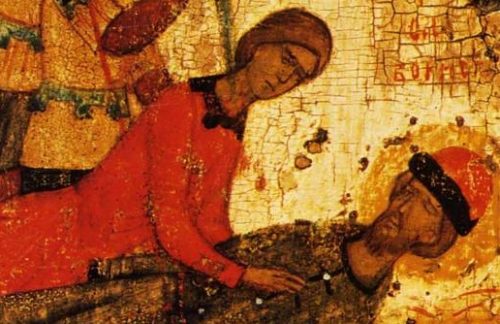
Saint Boris is one of the oldest and most popular Russian saints, but his same-sex love story has been buried until recently. Boris and his servant George the Hungarian loved each other deeply and were murdered together. The feast day of Saint Boris is July 24 — soon after the 2019 murder of a Russian LGBTQ activist. July 24 is also the same day that same-sex marriage became legal in New York in 2011.
Boris and George loved each other
Boris confided in George, prayed with him and gave him a magnificent gold necklace. When assassins came to kill Boris, George threw himself between Boris and his attackers, laying down his life for his beloved. The pair were killed together in 1015.
Boris and his younger brother Gleb are well known saints in Russia and Ukraine. They are often pictured together and many churches are named after them. Meanwhile the beloved George the Hungarian has gradually been downplayed and erased.
Boris was a prince and gifted military commander. He was married to a woman, but it was his enormous love for George that impressed his earliest biographers and hagiographers.
Slavic professor Simon Karlinsky has highlighted their gay love story in his analysis of the medieval classic, “The Legend of Boris and Gleb” compiled from 1040 to 1118. Karlinsky writes:
Boris had a magnificent gold necklace made for George because he “was loved by Boris beyond reckoning.” When the four assailants stabbed Boris with their swords, George flung himself on the body of his prince, exclaiming: “I will not be left behind, my precious lord! Ere the beauty of thy body begins to wilt, let it be granted that my life may end.” The assailants tore Boris out of George’s embrace, stabbed George and flung him out of the tent, bleeding and dying. After Boris died, first having forgiven his assassins, his retinue was massacred… Not only was the author of this story clearly sympathetic to the mutual love of Boris and George but he also seemed to realize that “the gratuitous murder of George resulted from his open admission of the nature of this love.”
 Karlinsky’s text above is quoted from “Passionate Holiness: Marginalized Christian Devotions for Distinctive People
Karlinsky’s text above is quoted from “Passionate Holiness: Marginalized Christian Devotions for Distinctive People” and “Gay Roots: Twenty Years of Gay Sunshine
.”
The man behind the murders was Boris’ half-brother Sviatopolk, who wanted to consolidate his power. He also had Boris’ brother Gleb killed at the same time.
In 1071 Boris and his brother Gleb became the first saints canonized by the Russian Orthodox Church. They were named “Passion Bearers” because, while they were not killed for their faith, they faced death in a Christlike manner, forgiving their murderers. Their father, St. Vladimir of Kiev, was the first Christian prince in Russia and their mother Anne was also Christian. Boris and Gleb are buried at the Church of St. Basil near Kiev in Ukraine.
George the Hungarian is also recognized as a co-martyr, passion bearer and saint in some traditions. His name is Георгий Угрин in Russian and Sandor in Hungarian.
Boris and George the Hungarian in art
A record of the love between Boris and George remains in artwork, especially the icons created close to their own time. Boris and George appear together in four scenes in a widely admired 14th-century icon from the Church of Saints Boris and Gleb in Kolomna, Russia. The icon’s central figures are Boris and his brother Gleb, but they are surrounded with smaller vignettes from their lives, including four scenes that reveal the close bond between Boris and George.
The four scenes of Boris and George are posted here, most of them for the first time in English. In the first scene, Boris confides his fear of death to George.
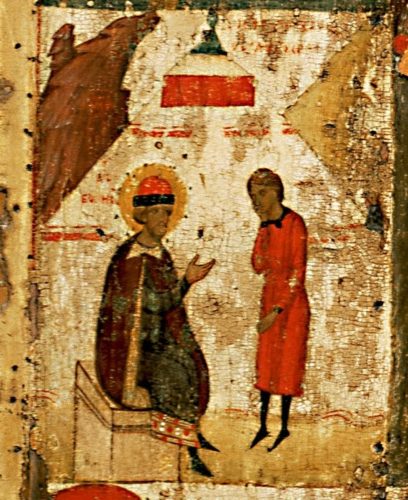
Boris confides his fears of death to George the Hungarian in a scene from “Saints Boris and Gleb with Scenes from Their Lives,” 14th century icon from the Church of Saints Boris and Gleb in Kolomna, Russia (Wikimedia Commons)
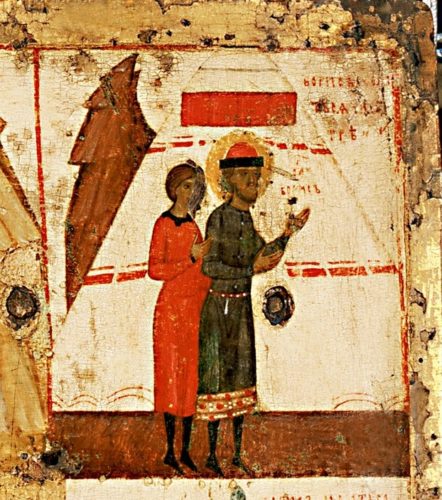
Boris and George the Hungarian pray together. Their physical closeness suggests spiritual and emotional intimacy. This scene comes from “Saints Boris and Gleb with Scenes from Their Lives,” 14th century icon from the Church of Saints Boris and Gleb in Kolomna, Russia (Wikimedia Commons)
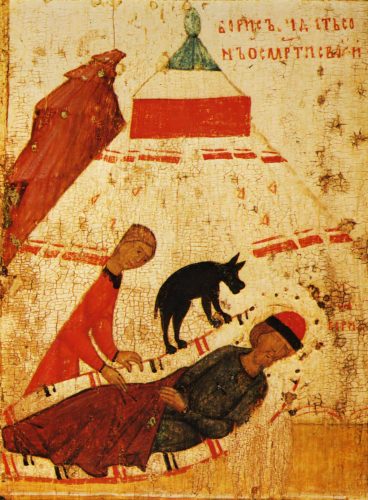
George the Hungarian observes Boris dreaming of his imminent death, symbolized by a wild beast. Notice how George gently places his fingers on the sleeping Boris. The scene comes from “Saints Boris and Gleb with Scenes from Their Lives,” 14th century icon from the Church of Saints Boris and Gleb in Kolomna, Russia (Wikimedia Commons)
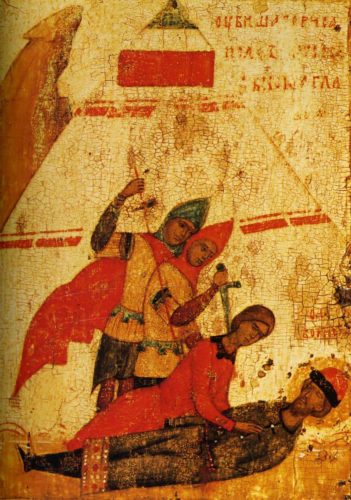
George the Hungarian embraces Boris, trying to protect the man he loves by placing himself between him and his murderers in a scene from “Saints Boris and Gleb with Scenes from Their Lives,” 14th century icon from the Church of Saints Boris and Gleb in Kolomna, Russia (Wikimedia Commons)
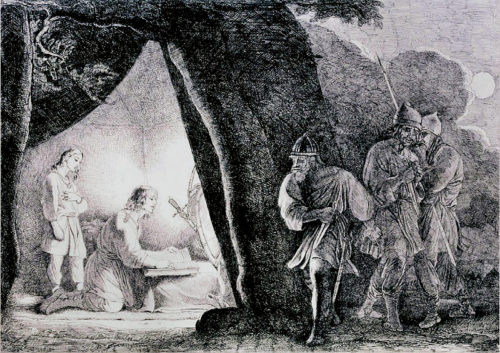
Boris and George the Hungarian are blissfully unaware of the murderers approaching in a 19th-century engraving by Fyodor Bruni (Wikimedia Commons)
The love between Boris and George is also honored in a controversial icon created in 2000. They share a halo in the golden icon “Saints Boris and George the Hungarian” by Brother Robert Lentz, a Franciscan friar and world-class iconographer known for his innovative icons.
In the icon George is restored to his rightful place beside Boris, properly honoring this extraordinary couple and the way they loved each other. It is one of 10 Lentz icons that have sparked controversy since in 2005 when conservative Roman Catholic leaders accused Lentz of glorifying sin and creating propaganda for a progressive sociopolitical agenda.
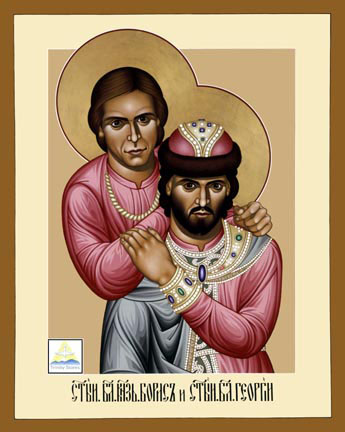
“Saints Boris and George the Hungarian” by Robert Lentz. Prints are available from Amazon and Trinity Stores.
Finnish artist Kalle Hamm created an image of Boris and George that is suitable for society now, when “icon” is more likely to mean a computer symbol than a religious figure. He writes their story using emoji with the goal of affirming LGBTQ people in a contemporary, accessible way. Hamm’s 2018 “New Icons” series includes these and many other same-sex pairs of saints who suffered for their beliefs.
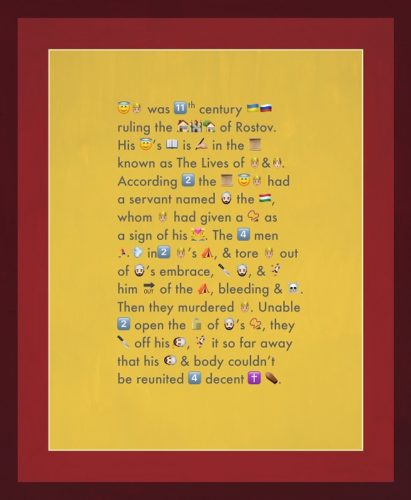
“New icon: Saint Boris and George the Hungarian” by Kalle Hamm
LGBTQ people in both Russia and the Ukraine still face legalized discrimination. May remembering Boris and George help bring equality for people of every sexual orientation and gender identity.
Remembering Russian LGBTQ activist Yelena Grigoryeva
It is impossible to consider Saint Boris and his beloved co-martyr George without remembering Yelena Grigoryeva (Елена Григорьева). She was found murdered July 21, 2019, with multiple stab wounds near her home in the city of Saint Petersburg, Russia. Her name was on a list of LGBTQ activists posted by a Russian website that urged people to hunt them down and offered prizes for those who attacked them, according to news reports. A suspect has been arrested.
Grigoryeva was a Facebook friend of Q Spirit founder Kittredge Cherry. “I was shocked and saddened by the news of Yelena’s murder. It came to me as a Google alert about a ‘gay saint.’ I give thanks for her life and pray for the other brave LGBTQ-rights activists in St. Petersburg. May her spirit live on in the company of Saint Boris and George!” she said.

Friendship between Yelena Grigoryeva) and Q Spirit’s Kittredge Cherry is shown on Facebook
Related links
Russian saints on Q Spirit / Jesus in Love:
Xenia / Andrei of St. Petersburg: Widow adopted husband’s identity and became a queer saint
Pavel Florensky and Sergei Troitsky: Russian theologian of same-sex love and his soulmate
Молитва Радужному Христу (Rainbow Christ Prayer in Russian)
Spiritual art supports Russia’s LGBT rights struggle
LGBTQ rights in Russia
In latest move, Russia adds ‘LGBT movement’ to official list of extremists and terrorists (NBC News, March 22, 2024)
In latest move, Russia adds ‘LGBT movement’ to official list of extremists and terrorists (NBC News, March 22, 2024)
Activists warn Russia expanding ‘gay propaganda’ law signals ‘heartbreaking’ turn on LGBTQ+ rights (Pink News, July 20, 2022)
Russian LGBTQ activist is killed after being listed on gay-hunting website (NBC News, July 23, 2019)
Russian LGBT Network Steps Up Efforts To Get Gay Men Out Of Chechnya (npr.org, May 5, 2017)
___
To read this post in Spanish / en español, go to Santos Queer:
Borís y Jorge: unidos en el amor y en la muerte
____
This post is part of the LGBTQ Saints series by Kittredge Cherry. Traditional and alternative saints, people in the Bible, LGBTQ martyrs, authors, theologians, religious leaders, artists, deities and other figures of special interest to lesbian, gay, bisexual and transgender and queer (LGBTQ) people and our allies are covered.
This article was originally published in July 2017 and was most recently checked for accuracy and expanded with new content on July 31, 2024.
Copyright © Kittredge Cherry. All rights reserved.
Qspirit.net presents the Jesus in Love Blog on LGBTQ spirituality.





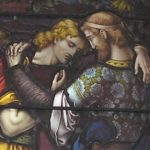
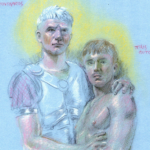
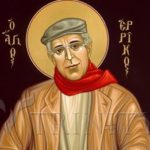


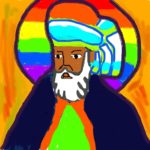
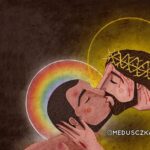
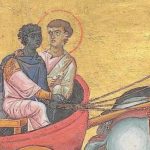



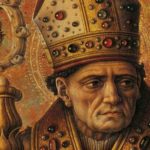
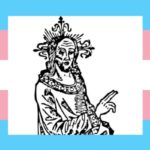
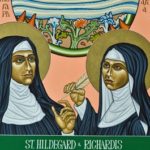
God bless
So the claim that they were romantically involved stems from one modern author interpreting the word “love” to mean romantic love despite the patent fact that even the governments in that era routinely used the word “love” in their correspondence to express the generic expected profession of Christian empathy toward their subjects and other leaders? Even enemy leaders routinely claimed to “love” each other in a strained – and usually hypocritical – attempt to trot out the standard sentiments. This is well known by anyone who has studied the medieval period to any extent at all.